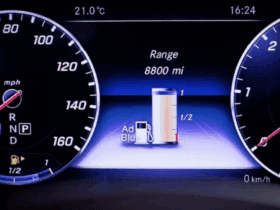Table of Contents
Engine Check Light Was On: Diagnosing Misfire in Mercedes-Benz ML63 AMG (M157 Engine)
When the engine check light turns on in a high-performance SUV like the Mercedes-Benz ML63 AMG, it’s not something to ignore. This flagship model, powered by the mighty M157 twin-turbo V8 engine, thrives on precision. Even minor ignition faults can quickly lead to severe performance issues, higher repair costs, and potential engine damage if left unresolved.
This case study highlights how a simple dashboard warning uncovered a cylinder misfire in cylinder 1 caused by a faulty ignition coil and worn spark plug. Through structured diagnostics, component testing, and targeted repairs, the vehicle was restored to peak AMG performance.

Customer Complaint
- Vehicle: Mercedes-Benz ML63 AMG (M157 engine)
- Issue Reported: Engine check light illuminated on the dashboard
- Noticed Symptoms: Slight engine vibration, reduced performance under load
Step 1: Initial Diagnostics – Fault Code Review
The first step was a full system scan using Mercedes-Benz XENTRY Diagnostic System. The following fault codes were retrieved:
| Code | Description | Possible Cause |
|---|---|---|
| P035149 | Actuation of ignition coil 1 has an electrical fault or open circuit | Internal coil failure |
| P035196 | Ignition coil 1 internal component fault | Coil damage |
| P030085 | Combustion misfire detected – signal above limit | Spark plug or coil fault |
| P030185 | Misfiring in cylinder 1 detected – above limit | Ignition coil/spark plug issue |
The codes pointed strongly toward a cylinder 1 ignition fault, with misfiring confirmed by the ECU.

Step 2: Step-by-Step Inspection
1. Spark Plug Inspection
- – Removed cylinder 1 spark plug.
- – Found excessive wear and carbon deposits, leading to weak combustion.
- – Spark gap was outside specification.
2. Ignition Coil Testing
- – Tested coil continuity and resistance.
- – Internal electrical fault confirmed (matching P0351 & P0351 codes).

3. Injector Actuation Test
- – Tested cylinder 1 injector response.
- – Actuation was normal → fuel delivery ruled out as a cause.
4. Wiring Harness Inspection
- – Checked connectors and harness continuity for ignition coil 1.
- – No corrosion or open circuits found.
With the fault counter rising during misfire monitoring, the ignition coil and spark plug were confirmed as defective.
Step 3: Repair Process – Replacing Faulty Components
- 1. Removed faulty ignition coil from cylinder 1.
- 2. Installed new OEM ignition coil to maintain AMG performance standards.
- 3. Replaced spark plug with a new OEM plug, ensuring correct gap.
- 4. Cleared fault memory and re-ran diagnostics.
Result: No misfire counters appeared after replacement.

Step 4: Final Testing
- – Conducted road test under different load conditions (idle, cruising, acceleration).
- – Engine ran smoothly with no hesitation or vibration.
- – Re-scanned ECU → no fault codes present.
The engine check light was off, confirming the repair was successful.

Symptom – Cause – Fix Table
| Symptom | Cause | Repair Fix |
|---|---|---|
| Engine check light on | Faulty ignition coil in cylinder 1 | Replaced ignition coil |
| Rough idle & vibration | Worn spark plug in cylinder 1 | Replaced spark plug |
| Misfire fault codes P0301, P0351 | Ignition coil electrical fault | Installed OEM coil + plug |
Key Takeaways
- – The engine check light was triggered by a failing ignition coil and spark plug.
- – High-performance engines like the M157 are more sensitive to ignition faults, requiring prompt repair.
- – Proper use of STAR/XENTRY diagnostics and step-by-step inspections is critical to avoid unnecessary part replacement.
- – Always use OEM components to maintain AMG performance and reliability.
FAQs
Q: Can a bad ignition coil trigger the check engine light?
Yes. A bad ignition coil disrupts spark delivery, causing misfires that trigger the check engine light with codes like P0301 or P0351.
Q: What are the symptoms of a bad ignition coil in a Mercedes AMG?
- – Rough idle
- – Vibration during acceleration
- – Reduced engine power
- – Poor fuel efficiency
- – Fuel smell in exhaust due to incomplete combustion
Q: Is it safe to drive with the check engine light on and a misfire?
No. Misfires send unburned fuel into the exhaust, risking catalytic converter damage and engine overheating. Driving in this condition can trigger limp mode.
Q: How do you fix a cylinder misfire in the ML63 AMG?
- – Scan fault codes with XENTRY
- – Inspect spark plugs for wear or fouling
- – Test ignition coils for continuity and resistance
- – Perform injector actuation test
- – Replace faulty coil and plug → clear codes and retest
Conclusion
In this case, the Mercedes-Benz ML63 AMG check engine light was caused by a faulty ignition coil and spark plug in cylinder 1. By following a structured diagnostic path and replacing the correct components, the vehicle was restored to full AMG performance.
This case underscores the importance of early diagnostics addressing the check engine light promptly can prevent expensive damage to critical components like the catalytic converter.
Related Hub Link
This case study is part of the Mercedes Check Engine Light – Complete Troubleshooting Hub, where you can explore more case studies, fault explanations, and repair guides.
Author Bio
Written by Mercedes Expert
With years of hands-on experience diagnosing and repairing Mercedes-Benz systems, he brings technical depth and practical case studies to help car owners, technicians, and enthusiasts troubleshoot complex automotive issues. His work focuses on clear repair guides, OEM-level procedures, and knowledge-sharing to empower both professionals and drivers.
Last update: September 2025






Leave a Reply